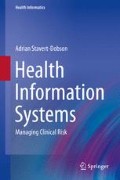Abstract
Defining and documenting the hazards which pertain to a particular Health IT solution is a fundamental part of a safety analysis. The content generated forms the basis of the safety argument, essentially it is the raw data on which the rest of the safety case will be built. Only by having a rigorous method in place is it possible to ensure that key hazards and causes are captured. A disorganised approach quickly brings into question the completeness and rigour of the exercise. A number of formal methods have emerged from the safety engineering domain. Sadly Health IT’s complexity, configurability and dependence on human factors means that many are difficult to apply and no single technique works across the board. Methods which employ collaborative brainstorming and multidisciplinary expertise have found to be useful in safety assessing Health IT. This chapter investigates how the Structured What-If Technique and other methods can be valuable in creating the hazard register.
Access this chapter
Tax calculation will be finalised at checkout
Purchases are for personal use only
References
Card A, Ward J, Clarkson P. Beyond FMEA: the structured what-if technique (SWIFT). J Healthc Risk Manag. 2012;31(4):23–9.
Health and Social Care Information Centre. ISB0129. Clinical risk management: its application in the manufacture of health IT systems version 2. UK Information Standard Board for Health and Social Care. London. 2013.
Health and Social Care Information Centre. ISB0160. Clinical risk management: its application in the deployment and use of health IT. UK Information Standard Board for Health and Social Care. London, UK; 2013.
Stalhandske E, DeRosier J, Wilson R, Murphy J. Healthcare FMEA in the veterans health administration. Patient safety and quality healthcare. 2009.
DeRosier J, Stalhandske E, Bagian J, Nudell T. Using health care failure mode and effect analysis: the VA National Center for Patient Safety. Prospective risk analysis system. Jt Comm J Qual Improv. 2002;28(5):248–67.
The Health Foundation. Safer Patients Initiative. Lessons from the first major improvement programme addressing patient safety in the UK. London: The Health Foundation; 2011.
Potts H, Keen J, Denby T, et al. Towards a better understanding of delivering e-health systems: a systematic review using the meta-narrative method and two case studies. 2011. NHS National Institute for Health Research. London. http://www.nets.nihr.ac.uk/__data/assets/pdf_file/0003/81462/ES-08-1602-131.pdf.
Health and Safety Executive. Marine risk assessment. Prepared by Det Norske Veritas. London, UK; 2001.
Wheeler D. Quality Digest. Problems with risk priority numbers. [Online]. Cited 2015 July. Available from: http://www.qualitydigest.com/inside/quality-insider-column/problems-risk-priority-numbers.html, http://www.qualitydigest.com/inside/quality-insider-column/problems-risk-priority-numbers.html. 2011.
International Organization for Standardization. ISO 31010: Risk management – risk assessment techniques. Geneva; 2009.
Andow P. Guidance on HAZOP procesdures for computer-controlled plants. Contract research report No. 26/1991. Health and safety executive. KBC Process Technology Ltd. 1991.
Hulin B, Tschachtli R. Identifying software hazards with a modified CHAZOP. PESARO 2011: the first international conference on performance, safety and robustness in complex systems and applications. Munich, Germany; 2011.
Author information
Authors and Affiliations
Rights and permissions
Copyright information
© 2016 Springer International Publishing Switzerland
About this chapter
Cite this chapter
Stavert-Dobson, A. (2016). Populating the Hazard Register. In: Health Information Systems. Health Informatics. Springer, Cham. https://doi.org/10.1007/978-3-319-26612-1_13
Download citation
DOI: https://doi.org/10.1007/978-3-319-26612-1_13
Published:
Publisher Name: Springer, Cham
Print ISBN: 978-3-319-26610-7
Online ISBN: 978-3-319-26612-1
eBook Packages: MedicineMedicine (R0)

